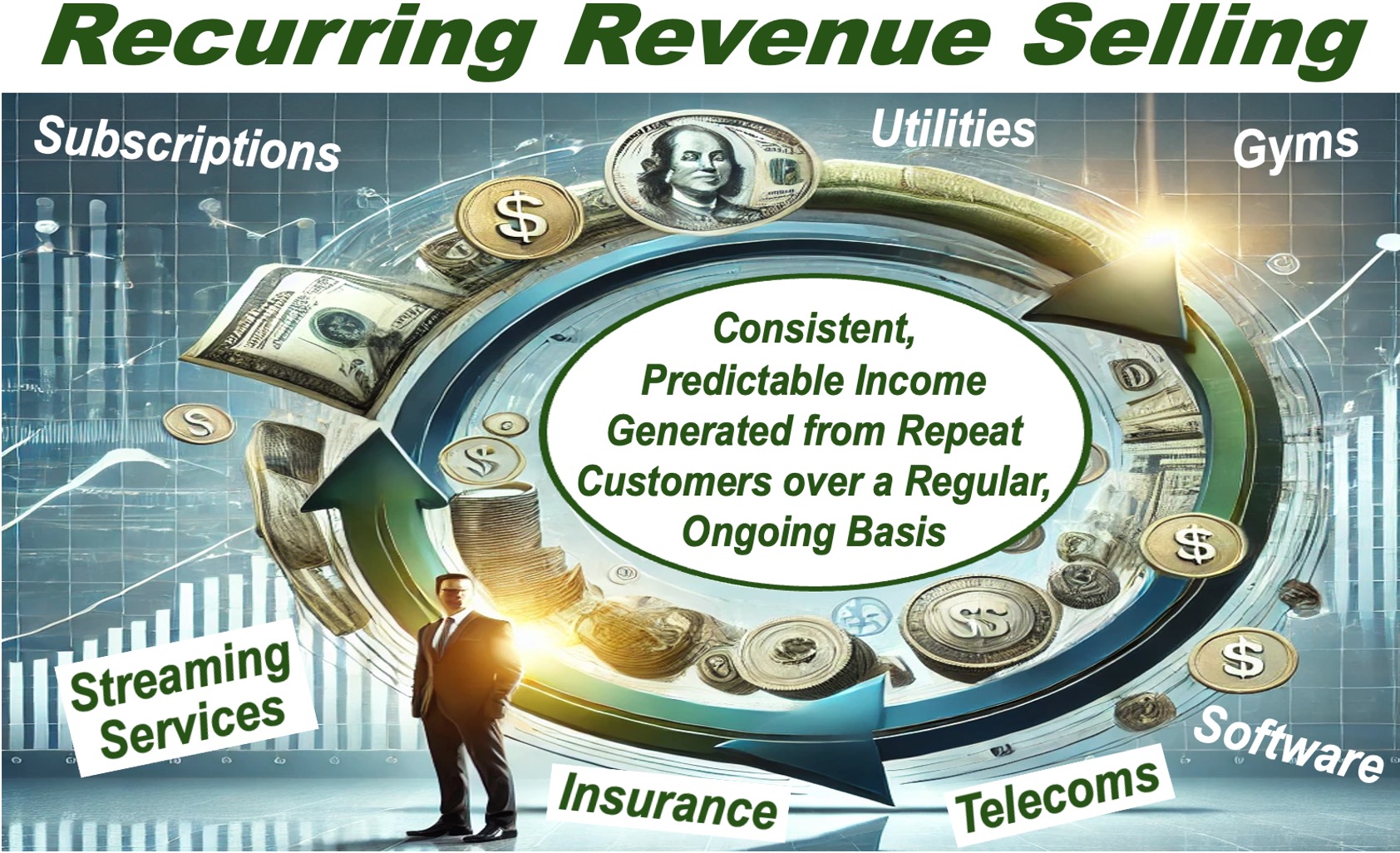Do you focus on generating consistent, ongoing revenue from your existing customers rather than just one-time sales? If so, you’re practicing Recurring Revenue Selling or Recurring Revenue Sales – you are a Recurring Revenue Seller.
Recurring revenue selling is practiced by companies that utilize a Recurring Revenue Business Model.
When you bring in a new customer, you don’t just move on and forget about them, shifting your attention to the next prospect. Instead, you build long-term relationships with your customers, ensuring they keep coming back and making repeat purchases.
If your business’s income primarily comes from repeat sales, your focus is on fostering both customer loyalty and brand loyalty.
Dealhub.io says the following about ‘recurring revenue’:
“Recurring revenue, also known as subscription revenue, is a type of income that is generated from businesses on a consistent and periodic basis.”
“This type of revenue stream is generated by subscription businesses and typically comes from recurring payments that are received at fixed intervals, such as monthly subscriptions or memberships.”
The Basics of Recurring Revenue Selling
At its core, recurring revenue selling involves offering products or services that customers need to repurchase regularly. These can include subscription-based services, maintenance contracts, or products that require frequent replenishment.
Examples include streaming services like Netflix and Spotify, subscription box services like Blue Apron, cable TV and internet providers, insurance companies, investment management firms, gyms, and utility companies.
The key idea is to create a reliable stream of income that you can count on month after month, or even year after year.

Why Recurring Revenue Matters
Recurring revenue is highly valuable to your business for several reasons:
-
Predictability and Planning
With recurring revenue, you can more accurately predict your future income. This stability allows you to plan and invest in your business with greater confidence.
When your customers commit to a recurring purchase, it indicates a deeper relationship and trust in your brand. This loyalty can lead to higher lifetime value per customer.
-
Growth Opportunities
As your base of recurring customers grows, your revenue can scale without needing to constantly find new customers.
For example, a company like Amazon initially offered just books to its customers but eventually expanded its offerings to include a wide range of products and services, such as Amazon Prime, streaming content, and grocery delivery, all to the same customer base.
This compounding effect can significantly boost your business’s profitability over time.
How to Implement Recurring Revenue Selling
To successfully implement this sales strategy, you need to consider the following steps:
-
Identify Suitable Products or Services
Determine which of your offerings can be sold on a recurring basis. This could be anything from a subscription service, print toner, razor blades, coffee pods, pet food, skincare products, batteries, office supplies, or any product that your customers will need to replace or update regularly.
-
Create Value for Your Customers
Ensure that your recurring offerings provide ongoing value. Whether it’s through regular updates, customer support, or delivering essential products on a schedule, your customers should feel that they are getting their money’s worth.
Ask yourself why your customers should continue buying from you and not elsewhere.
-
Build Relationships
Since recurring revenue depends on long-term customer relationships, focus on delivering excellent customer service. This includes personalized communication, addressing concerns quickly, and continually enhancing the customer experience.
Thanks to artificial intelligence, it is now possible to offer customer service 24/7 using chatbots. These AI-powered chatbots can provide almost human-like interactions, handling routine inquiries and issues efficiently.
They can respond instantly, providing your customers with the support they need at any time, day or night, which helps maintain satisfaction and reinforces their loyalty to your brand.
-
Monitor and Adjust
Continuously track the performance of your recurring revenue streams. Be prepared to adjust your offerings or pricing based on customer feedback and market trends to ensure your revenue remains steady.
In most industries and marketplaces today, things evolve and change much faster than they did a few decades ago. Make sure you stay up to date with every aspect of your sales approach and your products.
Similar Sales Methods
There are numerous sales methods in the business world. Here are the ones most similar to recurring revenue selling:
-
Subscription Selling
Directly involves generating recurring revenue by selling ongoing access to a product or service, often on a monthly or annual basis.
Focuses on building long-term relationships with customers, similar to recurring revenue selling, where customer retention and ongoing value are key.
Involves cultivating long-term relationships with customers to encourage repeat business, which aligns closely with the goals of recurring revenue selling.
Offers ongoing solutions to customer needs, often leading to repeat purchases or subscriptions, which are central to recurring revenue models.
Focuses on developing long-term relationships with key accounts, aiming for consistent, ongoing revenue from a select group of customers.
Brief History of Recurring Revenue Selling
The concept of recurring revenue selling has roots in traditional subscription models, like newspaper and magazine subscriptions, which have existed for centuries.
However, the term itself gained prominence in the late 20th and early 21st centuries with the rise of Software as a Service (SaaS) companies, such as Salesforce, that pioneered subscription-based business models.
Over the last few decades, recurring revenue models have expanded into various industries, fueled by advancements in technology and changes in consumer behavior, making it a widely adopted strategy today.
Final Thoughts
Recurring revenue selling is a powerful approach to ensuring a steady, reliable income for your business.
By focusing on long-term customer relationships and offering products or services that deliver ongoing value, you can create a predictable revenue stream that supports your business’s growth.
If you prioritize customer satisfaction and continually refine your offerings, your recurring revenue model can become a cornerstone of your success.
Good luck with your sales endeavors!
